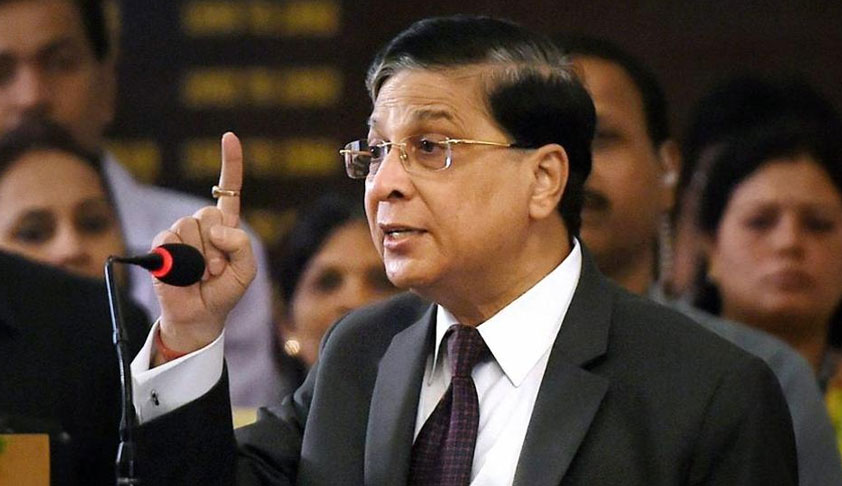oppn signs proposal for impeachment against CJI Dipak Misra
 NEW DELHI : In January, when the four senior most judges of the Supreme Court addressed the historic press conference turning the lens on administrative and judicial irregularity in the Supreme Court, no one thought that the sacrosanct position of the Chief Justice of India would be in question.
NEW DELHI : In January, when the four senior most judges of the Supreme Court addressed the historic press conference turning the lens on administrative and judicial irregularity in the Supreme Court, no one thought that the sacrosanct position of the Chief Justice of India would be in question.
Nearly two months after the four senior-most judges accused the Chief Justice of India of putting the democracy at risk, the Congress-led opposition has begun a signature drive to initiate an impeachment motion against Dipak Misra.
The Congress, backed by several opposition parties, is reportedly leading efforts to bring an impeachment motion in parliament against Chief Justice of India Dipak Misra. The parties are circulating an unprecedented petition for sacking the top judge, leaders of the Nationalist Congress Party (NCP) have confirmed.
NCP’s Majeed Memon said 20 signatures have been collected so far. Three Congress leaders, Ghulam Nabi Azad, Kapil Sibal and Ahmed Patel have reportedly signed the petition and five more signatories are from the NCP.”The Congress as the largest opposition party has belatedly initiated the proceedings for impeachment of the CJI ,” Majid Memon said on Tuesday.
Leaders of several opposition parties reportedly met and discussed the issue with the Leader of Opposition in Rajya Sabha, Ghulam Nabi Az ad.Ma ny opposition leaders, including those from Trinamool Congress, NCP and the CPI(M), have reportedly held discussions over the past few days. On Tuesday, West Bengal Chief Minister Mamata Banerjee, who is in Delhi, reportedly held discussions with senior lawyer Prashant Bhushan.
“The Samajwadi Party stands with the impeachment motion, which is about bringing independence and unquestionable integrity to the judiciary,” SP leader Ghanshyam Tiwari told news agency ANI.
To remove a judge, an impeachment motion should be initiated with the support of 50 MPs if it is introduced in the Rajya Sabha and 100 MPs if it is introduced in the Lok Sabha. The proposal can be submitted in either House.
However, the Speaker has the right to admit or reject it. In case the motion is accepted, the Speaker constitutes a three-member committee to look into the charges made against the judge concerned and if found guilty the House can take up the matter for voting.
A judge can be removed only on the ground of proved misbehavior or incapacity. In this case, the Congress and other opposition parties have taken up the issues raised by four senior Supreme Court judges in January.
Earlier in January, Justices Jasti Chelameswar, Ranjan Gogoi, MB Lokur and Kurien Joseph held an unprecedented press conference to put out some administrative differences with Chief Justice Misra. They accused the CJI of assigning important cases in an arbitrary manner to preferred junior judges.
The petition refers to allegations that sensitive cases were assigned to handpicked judges and the most-senior judges were ignored; the allegations were raised in January by the four top judges of the Supreme Court after the Chief Justice.
One of the first cases under the lens is that of the illegal gratification in the Prasad Education Trust case. This was a case related to a bribery scam in which medical institutions were alleged to have given kickbacks to senior members of the judiciary for clearances to set up medical colleges. It has been alleged that the CJI had submitted a false affidavit when he was an advocate appearing in a land acquisition matter.
Another issue which had stirred the hornet’s nest was the case of Judge Loya’s death. The four judges’ presser led to discussions on how the CJI’s refusal to list the PIL demanding an independent probe into Judge Loya’s death to a bench headed by senior most judges.
Congress later held another press conference and spoke about the case which had its lens also on BJP president, Amit Shah, as Judge Loya was hearing the Soharabuddin fake encounter case which has Shah as one of the accused.
What is the basic mode of disqualification of a Supreme Court judge in India? A Chief Justice, like any other Supreme Court judges can be impeached. This by the constitutional provision of Article 124. Article 124 acts to keep check on the judiciary by the legislature. However, unlike other countries there has been no cases of impeachment in India as of now.
Article 124 (4) of the Constitution of India: A Judge of the Supreme Court shall not be removed from his office except by an order of the President passed after an address by each House of Parliament supported by a majority of the total membership of that House and by a majority of not less than two-thirds of the members of that House present and voting has been presented to the President in the same session for such removal on the ground of proved misbehavior or incapacity. (With Agency Inputs ).

